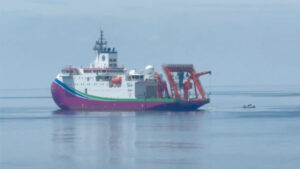By Kenneth Christiane L. Basilio, Reporter
THE Philippine Coast Guard (PCG) on Tuesday said it drove away a Chinese vessel conducting illegal research in waters north of the Philippines, where it was seen retrieving a deep-sea exploration craft.
Authorities said the Chinese research vessel Tan Suo 3 did not respond to radio challenges while it was reeling a submersible vessel capable of deep-sea dives after it was intercepted on Monday by BRP Teresa Magbanua , the PCG’s biggest ship.
The Chinese research vessel was detected about 90 nautical miles (166 kilometers) off the coast of Ilocos Norte province, where it was conducting “illegal” marine research, PCG spokesman Jay Tristan Tarriela told a news briefing.
The Chinese Embassy in Manila did not immediately reply to a Viber message seeking comment.
“We were actually monitoring the movement of the Chinese research vessel, whether they are only going to conduct freedom of navigation or we have to confirm whether they are carrying out marine scientific research not permitted and allowed by the Philippine government,” Mr. Tarriela said.
“For almost two days of monitoring by satellite, the commandant decided to deploy a coast guard vessel to make sure that it’s going to be escorted out of our exclusive economic zone and document their illegal activities,” he added.
Tensions between the Philippines and China over the South China Sea have worsened in the past year as Beijing continues to assert its sweeping claim that covers maritime features disputed by Manila.
China claims more than 80% of the South China Sea based on a 1940s map, which a United Nations-backed arbitration court voided in 2016 for being illegal.
The Chinese research vessel was recovering a manned submersible capable of diving to depths of 4.5 kilometers, Mr. Tarriela said, adding that the incident “strengthens the possibility” that previous sea drones found across the country had been deployed by China.
The Philippine Navy said in mid-April several sea drones found in the country’s waters were likely deployed by Beijing and may have been used to survey underwater terrain in preparation for underwater warfare.
The recovered drones, which Philippine Navy spokesman Rear Admiral Roy Vincent T. Trinidad said had a “50% to 80%” likelihood of being deployed by Beijing, can record water depth, temperature, salinity and underwater sounds that could be transmitted to land stations, motherships or other drones via satellite communication.
Mr. Tarriela said the PCG did not try to seize the submersible due to legal complications. “Our mandate is only for them to be prevented from doing marine scientific research.”
“We are currently formalizing the result of our operation, and that will be submitted to the National Task Force for the West Philippine Sea,” he added.
The Justice and Foreign Affairs departments, which are members of the task force, will formulate a response to China’s “illegal activity” in Philippine waters, he said.
SHOAL ACTIVITYMeanwhile, Chinese and Philippine ship activities near Scarborough Shoal spiked in the past year, with China’s coast guard gradually pushing its perimeter around the disputed shoal eastward, nearing the Philippines’ main island of Luzon, according to maritime transparency group SeaLight.
SeaLight’s monitoring detected 1.5 million Chinese ship identification pings around the shoal, up from 724,000 a year ago, while with Philippine activity surged fourfold to 200,000, Anna van Amerongen, SeaLight Tech Advisory Group director, told an online maritime forum.
“The perimeter around Scarborough Shoal has increased and became much more of a hotbed of activity,” she said.
Chinese ships have been preventing PCG vessels from getting within 32 kilometers of the shoal since May 2024, she added.
The shoal is 240 kilometers west of Luzon and is about 900 kilometers from Hainan, the nearest major Chinese landmass.
In 2013, the Philippines took the dispute over Scarborough Shoal to a United Nations-backed tribunal, which ruled in 2016 that China had interfered with Filipino fishermen’s rights to access the area. Beijing has since deployed a fleet of coast guard vessels to enforce its claim despite the ruling.
Manila is monitoring the situation at Scarborough Shoal and is trying to assert sovereignty over the disputed feature by ramping up its presence despite Chinese pushback, National Security Council Assistant Director-General Jonathan E. Malaya told the forum.
“Every instance wherein China carries out these activities supposedly to assert its control only demonstrates very clearly that it is acting contrary to international law,” Jay L. Batongbacal, director of the University of the Philippines Institute for Maritime Affairs and Law of the Sea, said at the same forum.
“The more that China tightens its grip around Scarborough Shoal, the more it loses it because it only demonstrates that its claim on it is illegal.”
The Philippines should file a second arbitration case against China for its conduct at the shoal, former Supreme Court Justice Antonio T. Carpio told the forum.
“We should be proceeding with the arbitration on the extended continental shelf,” he said. “Time is on China’s side, it is getting stronger every year.”
The Philippine government in June last year filed a claim with the United Nations (UN) seeking to register its extended shelf claim in the South China Sea amid repeated clashes with China.
Nations can extend their claims beyond the 200-nautical-mile exclusive economic zone if they provide evidence that their continental shelf reaches farther, securing rights to minerals and seabed resources, according to the UN Convention on the Law of the Sea.






